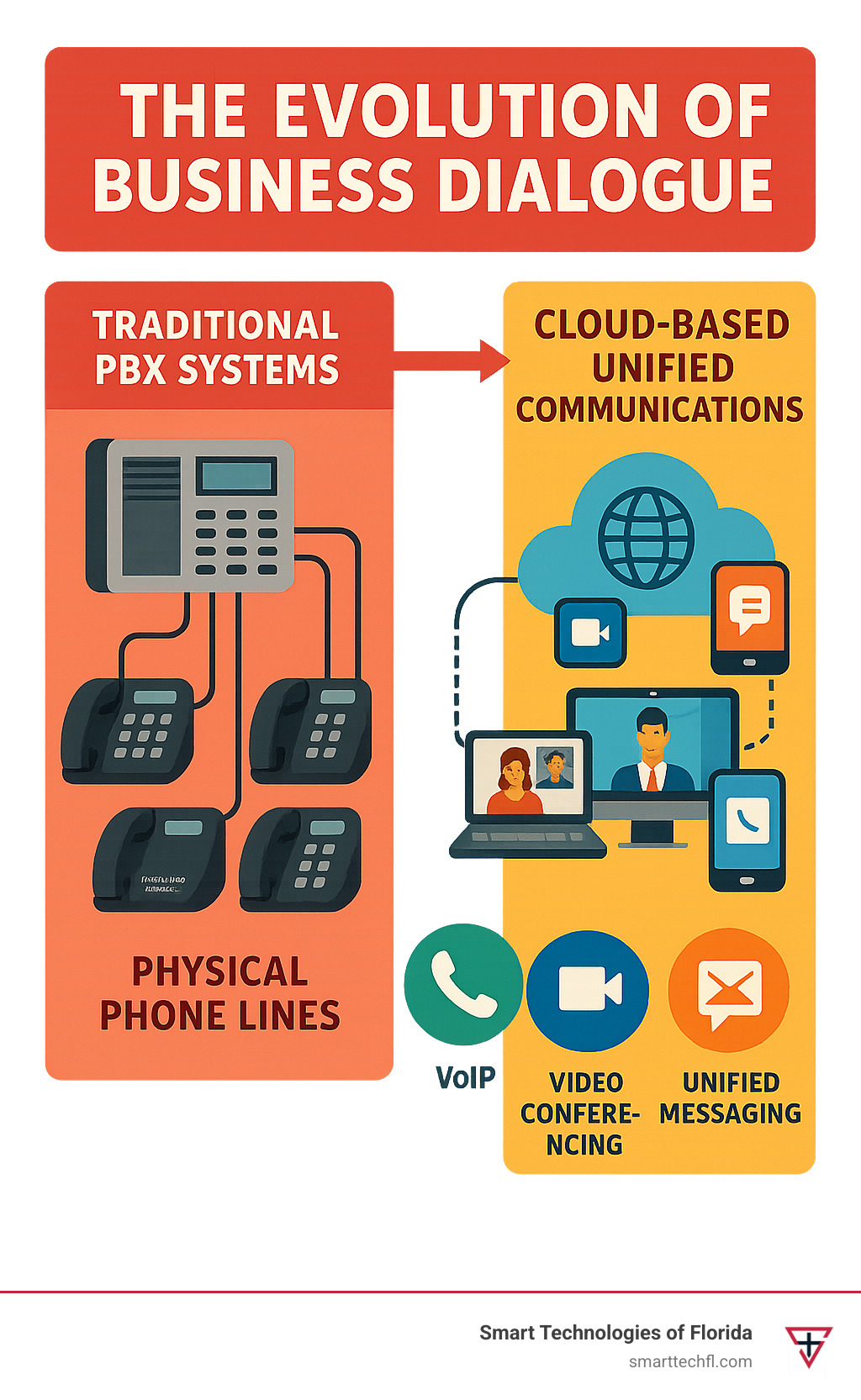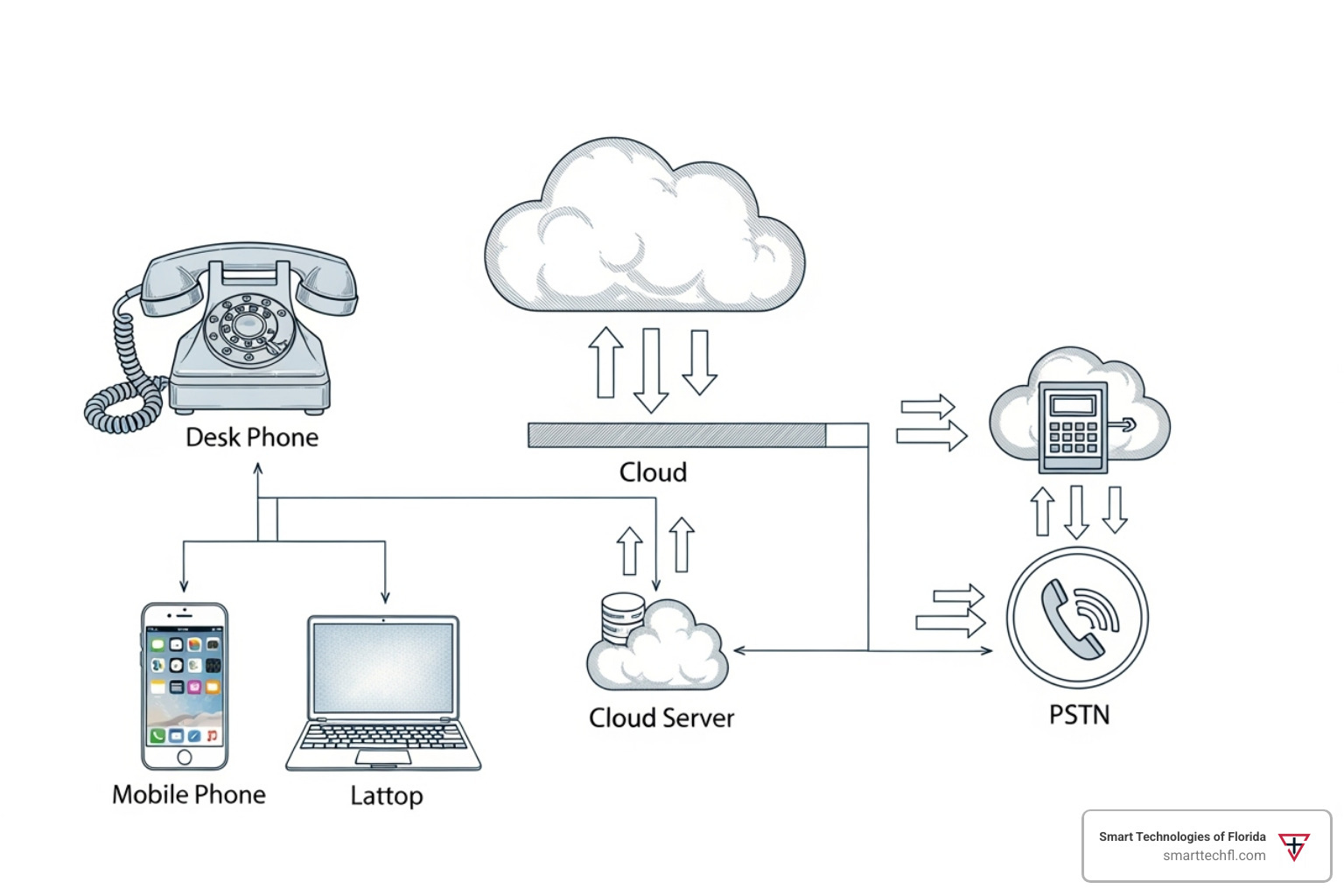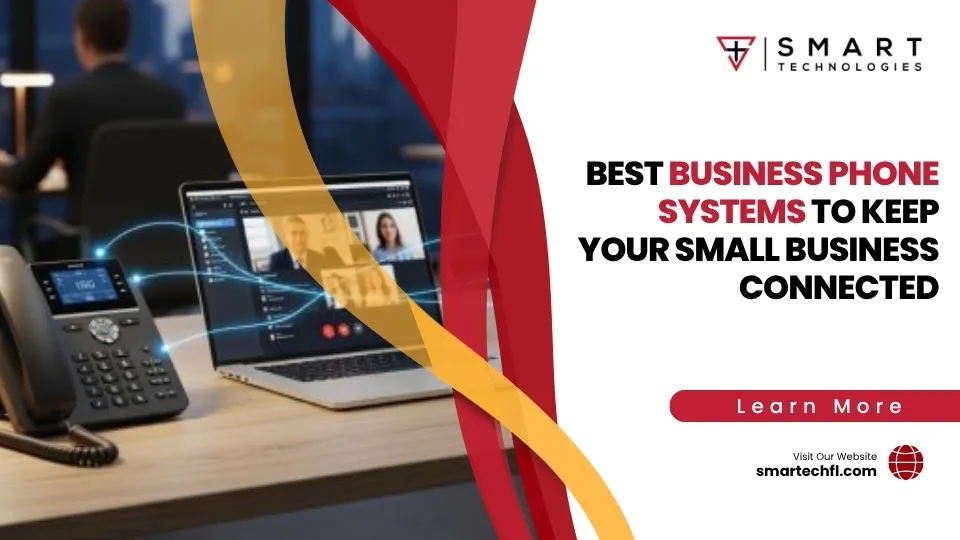Enterprise Voice Communications: Driving Business Forward
Enterprise voice communications has evolved far beyond simple phone calls. It’s now a complete digital platform connecting your team, customers, and business processes through voice, video, messaging, and collaboration tools.
What is Enterprise Voice Communications?
- Voice over Internet Protocol (VoIP) technology replacing traditional phone lines
- Unified Communications platforms combining voice, video, chat, and messaging
- Cloud-based systems that work across any device, anywhere
- Advanced features like auto-attendants, call routing, and mobile integration
- Business applications integrated directly into your communication workflow
The shift from traditional phone systems to modern enterprise voice is a fundamental change in how businesses operate. Outdated on-premise phone systems are giving way to flexible, cloud-based solutions that connect your entire organization through a single, powerful platform.
This evolution addresses critical pain points like reducing operational costs, improving customer service, and enabling staff to work effectively from anywhere. The numbers tell the story: modern enterprise voice solutions can be 46% less expensive than traditional on-site systems over five years, while delivering features impossible with legacy equipment.

This digital change is no longer an option; it’s a necessity for today’s hybrid work environments. Companies that accept this shift gain a significant competitive edge, allowing employees to work smarter and more efficiently, regardless of location. It’s about building a robust communication framework that supports your organization’s unique culture.
The Technology Powering Modern Voice
Modern enterprise voice communications are powered by a suite of technologies working together, including Voice over Internet Protocol (VoIP), Session Initiation Protocol (SIP) Trunking, and Unified Communications as a Service (UCaaS). These cloud-based technologies transform a simple phone call into a complete business communication experience.
These technologies work together seamlessly to create what we call our Business Communications Systems.
Core Technologies of Enterprise Voice Communications
Let’s break down the core components:
Voice over Internet Protocol is the game-changer. Instead of using old copper wires, VoIP converts your conversation into digital packets that travel across the internet. This makes voice communications less expensive, simpler to deploy, and significantly less difficult to maintain than traditional landline systems.
Private Branch Exchange (PBX) systems have moved to the cloud. These IP-PBX systems handle all your call routing and advanced features without requiring bulky hardware in your office.
The Public Switched Telephone Network (PSTN) is the traditional phone network. Your VoIP system connects to the PSTN to call regular landlines and mobile phones, acting as a universal translator between the digital and analog worlds.
Session Initiation Protocol (SIP) is the protocol that helps your communication devices and services work together. SIP Trunking replaces expensive traditional phone lines with internet connections, offering more flexibility and significant cost savings.

These core technologies form the foundation of modern VoIP Business Solutions, delivering superior flexibility and scalability.
The Role of Unified Communications and Integrations
Modern enterprise voice communications goes beyond just making calls. Unified Communications brings every communication channel into one platform:
- Unified messaging delivers voicemails to your email inbox.
- Video conferencing upgrades any voice call to a face-to-face meeting with one click.
- Instant messaging allows for quick, non-disruptive conversations.
- Presence shows you who’s available, in a meeting, or away from their desk.
The real power comes from CRM integration. When a customer calls, their history can automatically pop up on your screen, enabling personalized service. These collaboration platforms connect with the tools your team already uses, creating a seamless workflow.
Modern UCaaS platforms deliver a complete suite of features that transform business collaboration, providing seamless connection to the office from anywhere, maximizing the productivity of a mobile and remote workforce. This integrated approach is what makes our Unified Communications Solutions so effective.
Strategic Advantages of Modern Enterprise Voice Communications
Adopting modern enterprise voice communications delivers measurable benefits that go straight to the bottom line. This technology shift improves how your entire organization operates.
- Productivity Improvement: Modern systems eliminate phone tag and poor call quality. When employees can see who’s available, switch from voice to video, or answer their business line from anywhere, they get more done.
- Cost Efficiency: Enterprise VoIP is significantly less expensive to deploy and maintain than traditional systems. By eliminating costly hardware and reducing maintenance, businesses can cut communication bills substantially. One study found a modern voice solution cost 46% less over five years.
- Operational Flexibility: Your communication system can scale with your business needs. Adding new employees or adjusting for seasonal demand takes minutes, not weeks, without requiring new hardware.
- Improved Customer Experience: Professional auto-attendants and intelligent call routing ensure callers reach the right person quickly. Access to customer information during calls makes every interaction more personal and effective.
These advantages collectively support distributed workforces, making remote and hybrid work highly productive. Our Enterprise Communications Tools Key Benefits showcase how these systems drive businesses forward.

Essential Features and Functionalities
Modern enterprise voice communications systems are packed with intuitive tools to make your workday smoother:
- Auto-attendant: A professional automated receptionist that directs callers to the right person or department.
- Call routing: Intelligently directs incoming calls based on time of day, availability, or caller needs.
- Voicemail-to-email: Delivers voicemails as audio files (often with transcriptions) to your inbox.
- Find me/Follow me: Rings multiple devices in sequence (desk phone, mobile, etc.) so you never miss an important call.
- Mobile integration: Allows staff to make and receive calls from their business number on their personal devices.
- Conference calling: Supports large-scale meetings with participants from around the world.
- Call recording: Provides valuable data for training, quality assurance, and compliance.
These features represent some of the Top VoIP Features for Small Businesses, but they scale beautifully for larger organizations.
Calculating the ROI of a Modern Voice Solution
Understanding the return on investment is straightforward when you consider both immediate savings and long-term benefits.
- Reduced hardware costs: Cloud-based solutions eliminate the need for expensive on-premise equipment and maintenance contracts.
- Lower maintenance: Your provider handles system updates and security, freeing up your IT team for strategic projects.
- Predictable monthly pricing: Subscription-based models make budgeting simple, with no surprise repair or upgrade costs.
- Increased employee productivity: The biggest long-term value comes from a more connected and efficient team. When communication barriers disappear, your team accomplishes more.
The Total Cost of Ownership analysis consistently shows that modern voice solutions are more cost-effective. Our Cloud Telephony Pricing Guide for Businesses can help you understand what to expect.
Fortifying Your Communications: Security and Reliability
When your business relies on enterprise voice communications, security and reliability aren’t just nice-to-have features—they’re absolutely essential. Think of it this way: would you leave your front door open uped at night? Of course not. The same logic applies to your communication systems.

At Smart Technologies of Florida, we’ve seen how proper security measures can save businesses from costly breaches and embarrassing downtime. As we often discuss in our insights on Technology and Business Communication, building a robust and resilient infrastructure is the foundation of successful business operations.
Modern voice systems handle sensitive customer data, confidential business discussions, and critical operational communications. A single security breach or system failure can damage your reputation, disrupt operations, and potentially expose you to legal liability. That’s why we take a comprehensive approach to protecting your communications.
Security Best Practices and Key Components
Securing your enterprise voice communications requires multiple layers of protection working together seamlessly. End-to-end encryption forms the cornerstone of this protection, ensuring that your conversations remain private from the moment they leave your device until they reach their destination. No one can eavesdrop on your calls or intercept sensitive information.
Compliance requirements like HIPAA for healthcare organizations and GDPR for data privacy aren’t just regulatory checkboxes—they’re essential protections for your customers and your business. Modern voice solutions build these compliance features directly into their platforms, making it easier for you to meet your legal obligations without constant worry.
Session border controllers act like digital security guards for your network. These specialized devices sit at the edge of your communication system, carefully screening all incoming and outgoing traffic. They provide what we call “bulletproof protection for SIP trunking” by blocking malicious attempts to access your system while allowing legitimate communications to flow freely.
Network monitoring keeps a watchful eye on your system 24/7, automatically detecting unusual activity that might signal a security threat. Combined with secure administration protocols that strictly control who can access your system settings, these measures create a robust defense against both external attacks and internal security risks.
Encrypted connections ensure that all your data—whether voice calls, video conferences, or instant messages—travels safely through secure channels. Access controls let you define exactly who can use which features, while regular security updates keep your system protected against newly finded vulnerabilities.
Ensuring Business Continuity and Disaster Recovery
Security is only half the equation. Your communication system must also remain operational when things go wrong—and unfortunately, things do go wrong sometimes. Geo-redundancy spreads your communication infrastructure across multiple data centers in different locations. If one center experiences problems, your calls automatically route to another location without interruption.
Automatic failover systems work behind the scenes to maintain your communications during outages. For example, some enterprise systems achieve “99.999% uptime” through “Active-Active Server Architecture” that provides “100% call failover support.” This means if one server fails, another immediately takes over without dropping your calls.
Cloud-based resilience offers advantages that traditional on-premise systems simply can’t match. When your voice system lives in the cloud, it benefits from the provider’s massive infrastructure and expertise in managing geo-redundant infrastructure. This distributed approach naturally protects against localized disasters or equipment failures.
Remote work enablement has become more important than ever. Modern voice solutions ensure your team can maintain full communication capabilities whether they’re working from the office, home, or anywhere else. Call redirection features automatically route calls to alternative numbers, mobile phones, or voicemail systems when primary lines are unavailable.
The beauty of these systems is that they work transparently. Your team focuses on serving customers and growing the business while the technology handles the complex task of maintaining secure, reliable communications. That’s the kind of peace of mind every business deserves.
The Future of Voice: Trends Shaping Enterprise Communication
The world of enterprise voice communications is moving fast, and honestly, it’s exciting to watch. We’re not just talking about minor upgrades here – we’re looking at technologies that will fundamentally change how businesses connect with their teams and customers. The future is bringing us smarter, more intuitive communication tools that feel less like technology and more like natural conversation.
What makes this change particularly interesting is how Artificial Intelligence is weaving itself into everyday business conversations. We’re already seeing AI handle routine customer questions, but that’s just the beginning. Soon, your phone system will be smart enough to understand the mood of a conversation through sentiment analysis, helping managers identify when customers are frustrated or when team members might need support.
Real-time transcription is another game-changer that’s already making meetings more accessible and searchable. Imagine never having to ask “wait, what did they say about the budget?” again – everything is captured and searchable instantly. This technology is particularly valuable for businesses that need to maintain detailed records or support team members with hearing difficulties.
The impact of 5G networks can’t be overstated. With ultra-low latency and massive bandwidth improvements, mobile devices are becoming even more central to business communications. The quality difference between a desk phone and a smartphone call is disappearing, which means your team can maintain professional-grade conversations from anywhere.
Future Trends in Enterprise Voice Communications
What’s really fascinating is how deeper application integration is creating seamless workflows. Instead of juggling multiple apps, your communication system will work directly within your existing business tools. API-driven customization allows businesses to create exactly the communication experience they need, which aligns perfectly with the CPaaS Benefits for Business Communication we’ve seen transform organizations.
AI-powered assistants are becoming sophisticated enough to handle complex scheduling, manage customer inquiries, and even provide real-time coaching during important calls. Voice analytics goes beyond simple call recording – it analyzes patterns, identifies training opportunities, and helps optimize staffing based on actual conversation data.
Improved mobile integration means your personal device becomes a fully-featured business endpoint without compromising security or professionalism. This trend supports the growing need for flexible work arrangements while maintaining the communication standards customers expect.
The continued dominance of cloud-based solutions ensures that these innovations reach businesses of all sizes quickly and affordably. This democratization of advanced communication technology means smaller companies can compete with enterprise-level communication capabilities.
Looking ahead, Centralized Communication for Businesses isn’t just about having one platform – it’s about creating an intelligent communication ecosystem that adapts to your business needs in real-time. The future of enterprise voice communications is remarkably bright, promising tools that don’t just connect us, but truly understand and improve how we work together.
Frequently Asked Questions about Enterprise Voice Communications
When businesses explore enterprise voice communications, many thoughtful questions arise. Here are answers to the most common concerns.
How does enterprise voice differ from a traditional phone system?
Think of it as comparing a smartphone to a rotary phone. Traditional systems use physical copper lines and hardware, while enterprise voice communications uses Voice over Internet Protocol (VoIP) to send calls over the internet. Beyond just calls, enterprise voice integrates video meetings, messaging, and business software into a single platform. It’s also more scalable—you can add users with a few clicks—and cost-effective, replacing large upfront hardware costs and maintenance bills with predictable monthly fees. Unlike desk-bound traditional systems, enterprise voice lets your team use their business number anywhere.
How do enterprise voice solutions support a hybrid workforce?
This is a key strength of enterprise voice communications. It creates a seamless experience across all devices, allowing an employee to take a call on their desk phone and switch to their mobile or laptop without interruption. Features like mobile integration and presence indicators are vital, letting team members see who is available and ensuring calls find people on their preferred device. Video conferencing and instant messaging break down distance barriers, while find me/follow me routing ensures important calls always connect. Because the system is cloud-based, it provides excellent business continuity; if the office is inaccessible, the team can keep working from anywhere.
What are the first steps to choosing the right solution?
Choosing the right enterprise voice communications solution is a clear process.
- Assess your current situation. Identify your team’s frustrations, such as missed calls from remote workers or high phone bills. Understanding these pain points will focus your search.
- Consider your future needs. Think about growth, new locations, or integrations with specific business applications. Planning ahead prevents costly changes later.
- Evaluate your internet connection. Since the system runs online, a reliable, high-speed connection is crucial.
- Find the right partner. Look for a provider with deep experience in migration, integration, and ongoing support. They should help align the technology with your business goals.
When done right, enterprise voice communications becomes an invisible foundation that makes your business work better.
Conclusion: Voice as a Strategic Asset
The world of business moves fast, and enterprise voice communications has evolved right alongside it. What started as simple phone calls has transformed into something much more powerful – a complete communication platform that connects your people, processes, and possibilities.
Think about it: your communication system touches every part of your business. It’s how your team collaborates on projects, how customers reach you, and how deals get closed. When that system works seamlessly, everything else flows better too.
We’ve seen how modern voice solutions break down the old barriers. Your sales team can take calls from home just as easily as from the office. Your customer service rep can access client information instantly during a call. Your managers can see who’s available for an urgent question without playing phone tag. This isn’t just about future-proofing your technology – it’s about creating a competitive advantage that grows with your business.
The numbers don’t lie either. Companies using modern enterprise voice communications see real savings – sometimes cutting costs by more than half compared to traditional systems. But the bigger win? The productivity gains when your team can work smarter, not harder.
Security and reliability aren’t afterthoughts anymore. They’re built into the foundation of modern systems. Your conversations stay private, your business keeps running even during unexpected events, and you can sleep better knowing your communication backbone is solid.
Looking ahead, the future gets even more exciting. Artificial intelligence will make your phone system smarter, helping with everything from routing calls to analyzing customer sentiment. 5G networks will make mobile communication crystal clear. And deeper integrations mean your communication tools will work even more seamlessly with the software you already use.
At Smart Technologies of Florida, we’ve spent 23 years learning that technology is only as good as the people using it. That’s why we take a people-centric approach to every solution we design. We don’t just install systems – we help your team accept new ways of working that make their days easier and more productive.
Business change doesn’t have to be overwhelming. With the right partner, it becomes an opportunity to open up your organization’s potential. We understand that every business is unique, which is why we focus on strategic innovation that fits your specific goals and culture.
Ready to find what modern communication can do for your business? Explore our business communication solutions to see how we can drive your organization forward. Because when your people can communicate effortlessly, there’s no limit to what they can achieve together.












